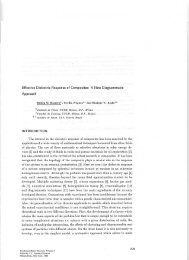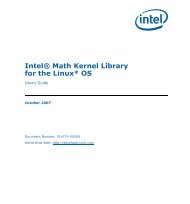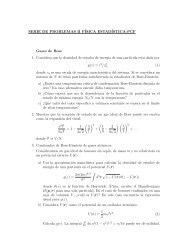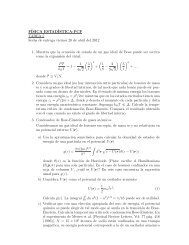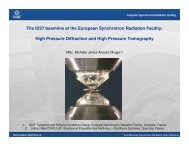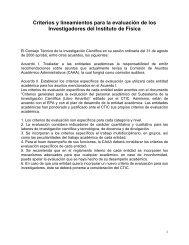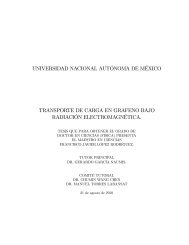Surface Plasmons on Metal Nanoparticles - UNAM
Surface Plasmons on Metal Nanoparticles - UNAM
Surface Plasmons on Metal Nanoparticles - UNAM
Create successful ePaper yourself
Turn your PDF publications into a flip-book with our unique Google optimized e-Paper software.
3814 J. Phys. Chem. C, Vol. 111, No. 10, 2007 NoguezFigure 6. Extincti<strong>on</strong> efficiency as a functi<strong>on</strong> of the wavelength of theincident light for the regular decahedr<strong>on</strong> and its truncated morphologiesfor parallel light polarizati<strong>on</strong>.shown in Figure 6, is composed of 10 planar triangular faces,which resemble two pentag<strong>on</strong>s. However, when the NP’s sizeis in the range between 1 and 5 nm, the regular DH is rarelyobserved, and the most comm<strong>on</strong> shapes are the truncated <strong>on</strong>es:the Marks and rounded DHs. The first structure was introducedby Marks 81 and is remarkably stable. In very clean growthc<strong>on</strong>diti<strong>on</strong>s, or with weak interacti<strong>on</strong>s with substrates, this is <strong>on</strong>eof the predominant shapes for the discussed size interval. Away to describe the Marks DH is as a regular DH, which hastruncati<strong>on</strong>s <strong>on</strong> its facets, as shown in Figure 6. When thetruncati<strong>on</strong> reaches a maximum value, a morphology with theshape of a star DH is formed. Another type of DH NP, whichis often observed, corresp<strong>on</strong>ds to the rounded pentag<strong>on</strong>al NP,in which the truncati<strong>on</strong> has a minimum possible value producinga c<strong>on</strong>trast reducti<strong>on</strong> in the borders. This type of particle isfrequently formed when colloidal growth methods are used. 22Here, we briefly discuss the SPRs of the rounded dh with atruncati<strong>on</strong> of r ) 1/8, the Marks dh with r ) 1/6, the star, andthe regular DH. A more detailed discussi<strong>on</strong> can be found inrefs 27 and 80.Due to the symmetry of the DH NP, two different polarizati<strong>on</strong>sof the incident electromagnetic field are present: when EBis parallel or perpendicular to the pentag<strong>on</strong>al motif. When theelectric field is perpendicular to the pentag<strong>on</strong> of the regular DH,the spectrum shows a peak with its maximum at about 358 nmand has a fwhm of 90 nm. It was found that SPRs present atthe perpendicular polarizati<strong>on</strong> are not affected with any truncati<strong>on</strong>,except for the star DH, 80 where the main SPR is red-shiftedby 100 nm and is 5.5 times more intense, and its fwhm isnarrowed to 40 nm. 80 On the other hand, the parallel polarizati<strong>on</strong>is more sensitive to the different truncati<strong>on</strong>s. In Figure 6, Q extof the regular, rounded, Marks, and star DHs, when EB is parallel,are shown. The resp<strong>on</strong>se of the star decahedral is totally differentsince it shows res<strong>on</strong>ances in a very wide range of wavelengths.For the parallel polarizati<strong>on</strong>, the rounded decahedra show thesame effect as a functi<strong>on</strong> of the truncati<strong>on</strong> as observed in thecase of truncated cubes. The main res<strong>on</strong>ance is blue-shifted,and becomes the most intense peak after truncati<strong>on</strong>.VI. Influence of Physical Envir<strong>on</strong>ment <strong>on</strong> <str<strong>on</strong>g>Surface</str<strong>on</strong>g><str<strong>on</strong>g>Plasm<strong>on</strong>s</str<strong>on</strong>g> Res<strong>on</strong>ancesWe showed that with small changes of the morphology it ispossible to tune the SPRs of NPs. Here, we want to study howthese SPRs are influenced if the physical envir<strong>on</strong>ment ismodified. In this directi<strong>on</strong>, we have already shown how theSPRs are shifted if the dielectric properties of the surroundingmedia are changed. In particular, we showed that the SPRs ina medium with refracti<strong>on</strong> index n > 1 are red-shifted withrespect to those in vacuum. Furthermore, this shift depends <strong>on</strong>the proper mode itself: the larger the wavelength of theeigenmode, the greater the red shift, and the more spread outthe SPRs. However, we are interested not <strong>on</strong>ly in the case whenthe dielectric properties are changed but also when the physicalenvir<strong>on</strong>ment of the NP becomes different. We w<strong>on</strong>der whathappens to the SPRs when the particles lie <strong>on</strong> a substrate orwhen they are close enough that the dilute limit is not l<strong>on</strong>gervalid, and the electromagnetic interacti<strong>on</strong>s am<strong>on</strong>g NPs shouldbe c<strong>on</strong>sidered.These two situati<strong>on</strong>s are of great importance in a large varietyof problems that have promising technological applicati<strong>on</strong>s, likesurface-enhanced Raman scattering (SERS), 82-84 catalytic processes,85,86 plasm<strong>on</strong>ic devices, 87,88 and others. For instance, inthe case of the electromagnetic effect in SERS, the anomalousenhancement of the optical resp<strong>on</strong>se has been examined byadsorbing molecules at n<strong>on</strong>-flat metallic surfaces and at NPsof different shapes. Although the optical spectra of adsorbedmolecules might carry informati<strong>on</strong> about specific features ofthe molecular electr<strong>on</strong>ic structure or charge-transfer mechanisms,the informati<strong>on</strong> sought in the optical resp<strong>on</strong>se ofsupported particles is related more to their shape, substrateinducedmultipolar coupling, or local field effects. The calculati<strong>on</strong>of the field at the surface of these NPs requires the fullsoluti<strong>on</strong> of the optical resp<strong>on</strong>se problem.In this secti<strong>on</strong>, we study two important systems where thephysical envir<strong>on</strong>ment of the isolated or suspended NPs ischanged. First, we analyze the SPRs when the particle is placedabove a substrate. Sec<strong>on</strong>d, we examine the SPRs for a linearchain of NPs, which are close enough that they interact becauseof the local electromagnetic field.A. Supported <strong>Nanoparticles</strong>. The optical resp<strong>on</strong>se ofmetallic NPs deposited <strong>on</strong> a substrate is also characterized bythe presence of SPRs. The locati<strong>on</strong> and broadening of theseres<strong>on</strong>ances depend <strong>on</strong> the geometrical and dielectric propertiesof the system. When the system is under the acti<strong>on</strong> of an externalEM field, it induces a charge polarizati<strong>on</strong> <strong>on</strong> the particle thatcauses a charge distributi<strong>on</strong> <strong>on</strong> the substrate, which in turnsalso affects the NP. In the quasistatic limit, this chargedistributi<strong>on</strong> can be seen as the image charge distributi<strong>on</strong> of theNP, as shown in Figure 7. Although the dipolar approximati<strong>on</strong>might be sufficient for describing the optical resp<strong>on</strong>se of anisolated sphere, the substrate-induced field acting <strong>on</strong> the amplevolume of the NP is no l<strong>on</strong>ger homogeneous in space, andmultipolar modes of very high order might excite in additi<strong>on</strong>to the dipole (see Figure 7b). The interacti<strong>on</strong> between the NPsis also important, especially in the case of a high c<strong>on</strong>centrati<strong>on</strong>of them. However, the study of a single supported particle canbe also performed in the dilute regime. 89-93Different authors have included the multipolar interacti<strong>on</strong>sc<strong>on</strong>sidering particles of different shapes; 91-97 however, thenumerical complexity of the problem restricts the number ofmultipolar modes taken to describe the system. A powerfultheoretical method was developed to calculate the opticalresp<strong>on</strong>se of a particle-substrate system using the spectralrepresentati<strong>on</strong>. 91 With this method, <strong>on</strong>e is also able to includea larger number of multipoles, allowing the treatment of particlescloser to the substrate. The inclusi<strong>on</strong> of multipolar interacti<strong>on</strong>sbetween the particle and its image gives rise to res<strong>on</strong>ancesadditi<strong>on</strong>al to the dipolar <strong>on</strong>e. The structure of these res<strong>on</strong>ancesis more evident when the c<strong>on</strong>trast between the dielectric




